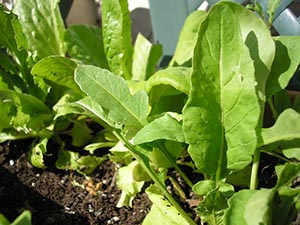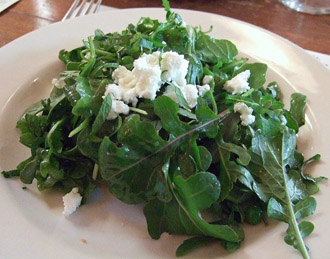Arugula Nutrition facts
Arugula, also known as salad or garden rocket, is one of the nutritious leafy greens originating from the Mediterranean. It is a small, low-growing annual herb with dandelion-like succulent leaves, elongated and lobular, distinguished by prominent green veins.
Botanically, it belongs to the Brassicaceae family vegetables akin to mustard greens, cauliflower, kale, among others.
Scientific name: Eruca sativa. Some of the common names of this greens are rucola, rucoli, rugula, colewort, roquette, etc.
 |
| Arugula. Notice tender deep-green leaves. As the plant grows further, its leaves turn lobular as in dandelion. (Photo courtesy: vicWJ) |
Salad rocket, or arugula, is a fast-growing crop suited for cool seasons. Thriving in well-drained, fertile soil and ample sunlight, it typically reaches heights of 2-3 feet and boasts creamy-white edible flowers. With a quick turnaround, its leaves are ready for harvest just 40 days after sowing.
When young, arugula leaves bear a light green hue resembling spinach but lack lobulation. They offer a milder flavor compared to mature greens, which are known for their peppery, spicy taste.
Eruca vesicaria, a closely related species to E. sativa, hails from the Iberian Peninsula and mountainous regions of northwest Africa. Its leaves exhibit deeper lobulation compared to the Mediterranean variety.
Not only are the leaves of arugula prized, but its flowers, fruit pods, and seeds also serve as delicacies.
Health Benefits of Arugula
Similar to other leafy greens, arugula is also considered a very low-calorie vegetable. With just 25 calories per 100 grams of fresh leaves, it packs a plethora of vital phytochemicals, antioxidants, vitamins, and minerals that can greatly contribute to health.
Arugula, commonly known as salad rocket, boasts an ORAC value (Oxygen Radical Absorbance Capacity, a measure of antioxidant potency) of approximately 1904 µmol TE per 100 grams.
Belonging to the Brassica family, arugula greens are abundant in certain phytochemicals like indoles, thiocyanates, sulforaphane, and isothiocyanates. These compounds collectively combat the carcinogenic effects of estrogen, potentially offering protection against cancers such as prostate, breast, cervical, colon, and ovarian cancers by inhibiting cancer cell growth and exerting cytotoxic effects on cancer cells.
Additionally, Di-indolyl-methane (DIM), a lipid-soluble metabolite of indole, exhibits immune-modulating, antibacterial, and antiviral properties by enhancing Interferon-gamma receptors. DIM is currently being investigated for its potential in treating recurrent respiratory papillomatosis caused by the Human Papilloma Virus (HPV) and is undergoing Phase-III clinical trials for cervical dysplasia.
Fresh arugula is rich in folates, with 100 grams of fresh greens containing 97 µg or 24% of the recommended daily intake of folic acid. When consumed by expectant mothers during conception, folate may help prevent neural tube defects in newborns.
Similar to kale, arugula is an excellent source of vitamin A, with 100 grams of fresh leaves providing 1424 µg of beta-carotene and 2373 IU of vitamin A. Carotenes convert to vitamin A in the body. Studies suggest that the presence of vitamin A and flavonoid compounds in green leafy vegetables may offer protection against skin, lung, and oral cavity cancers.
This vegetable is also rich in the B-complex group of vitamins, including thiamin, riboflavin, niacin, vitamin B-6 (pyridoxine), and pantothenic acid, which are crucial for optimal cellular enzymatic and metabolic functions.
Arugula leaves contain significant levels of vitamin C, a potent natural antioxidant. Foods high in vitamin C aid in protecting the body against scurvy, boosting immunity against infectious agents, and scavenging harmful, pro-inflammatory free radicals.
Arugula stands out as an excellent vegetable source of vitamin K, providing approximately 90% of the recommended intake in a 100-gram serving. Vitamin K plays a potential role in bone health by promoting osteotropic activity (bone formation and strengthening) and may help limit neuronal damage in the brain, potentially benefiting patients with Alzheimer's disease.
Furthermore, arugula leaves contain adequate levels of minerals, particularly copper and iron. They also contain small amounts of other essential minerals and electrolytes such as calcium, potassium, manganese, and phosphorus.
| Principle | Nutrient Value | Percent of RDA |
|---|---|---|
| Energy | 25 Kcal | 1% |
| Carbohydrates | 3.65 g | 3% |
| Protein | 2.58 g | 5% |
| Total Fat | 0.66 g | 3% |
| Cholesterol | 0 mg | 0% |
| Dietary Fiber | 1.6 g | 4% |
| Vitamins | ||
| Folates | 97 µg | 24% |
| Niacin | 0.305 mg | 2% |
| Pantothenic acid | 0.437 mg | 8% |
| Pyridoxine | 0.073 mg | 6% |
| Riboflavin | 0.086 mg | 7% |
| Thiamin | 0.044 mg | 4% |
| Vitamin C | 15 mg | 25% |
| Vitamin A | 2373 IU | 79% |
| Vitamin E | 0.43 mg | 3% |
| Vitamin K | 108.6 µg | 90% |
| Electrolytes | ||
| Sodium | 27 mg | 2% |
| Potassium | 369 mg | 7.5% |
| Minerals | ||
| Calcium | 160 mg | 16% |
| Copper | 0.076 mg | 8% |
| Iron | 1.46 mg | 18% |
| Magnesium | 47 mg | 12% |
| Manganese | 0.321 mg | 14% |
| Phosphorus | 52 mg | 7.5% |
| Selenium | 0.3 µg | <1% |
| Zinc | 0.47 mg | 5% |
| Phyto-nutrients | ||
| Carotene-ß | 1424 µg | |
| Carotene-a | 0 µg | |
| Lutein-zeaxanthin | 3555 µg |
Selection and Storage
Fresh arugula is typically available year-round in markets. When purchasing, look for crisp, vibrant green, and tender young leaves. Avoid arugula with flowers, as the leaves tend to be tough and bitter. Prior to cooking, discard any bruised, wilted, or yellowed leaves and stems.
To store arugula, treat it similarly to other greens like a href="spinach.html">spinach, purslane, and kale. Keep it in the vegetable compartment of the refrigerator, ensuring the humidity is set to high to maintain freshness.
Preparation and Serving methods
Field-grown arugula, typically available at local farmer markets, is commonly sold with its root intact. To prepare it, start by cutting open the bunch and removing any thick stems. Discard any leaves that are yellow, wilted, or bruised. Next, place the leaves in a large bowl of cold water and swish them around, similar to how you would clean spinach, to remove any sand, soil, or dirt. Once cleaned, drain the water and gently pat the arugula dry using a moisture-absorbent cloth before using it in cooking.
Here are some serving tips:
 |
| Rocket salald. Photo courtesy: ralphandjenny |
Delicate young rocket leaves make a wonderful enhancement to salads, sandwiches, and burgers.
Crisp greens are versatile, suitable for soups, stews, juicing, or as a leafy green in various dishes.
Create a delicious Italian-inspired arugula pasta topped with goat cheese.
Indulge in garlic toasts paired with leek-arugula vichyssoise for a delightful culinary experience.
Safety Profile
Salad rocket (arugula) contains lower levels of oxalates (7 mg per 100 g) compared to spinach (567 mg per 100 g), purslane (561 mg per 100 g), celery (25 mg per 100 g), and similar leafy greens. It is considered safe for consumption during pregnancy and lactation. (Medical disclaimer).
Also read ≻≻-
≻≻- Spinach Nutrition facts.
≻≻- Kale Nutrition facts.
≻≻- Back to Vegetables from Arugula (Salad Rocket). Visit here for an impressive list of vegetables with complete illustrations of their Nutrition facts and Health benefits.
≻≻- Back to Home page.
Further Reading:
Stanford School of Medicine Cancer information Page-Nutrition to Reduce Cancer Risk.
Vegetables Oxalate- Oxalosis and Hyperoxaluria Foundation.